Hi there. This might be a good question since I haven't found a definitive answer around here, not even at Sony's. I've got a series of pictures and wanted to make a project as 2.35:1 (21:9 and not 2.21:1).
Some people would recommend make a new project as 4:3 or 16:9 - "letterbox" (the only 2 DARs supported by DVD) and then what? I don't get a value such as 2.35:1 when I render as MPEG2. Only 2.21:1 is available. 720/2,35 = 306. 306 is not a multiple of 16. That will leave me the nearest option which is 304 (an error of -0,2%). What can I do?
Trying to render as 2.21:1 is also a problem, I guess.
Anyway, this is my workaround (what I was trying to do) but it didn't work at all: File> Properties> NTSC DV Widescreen at 23,976, setting the width as 720 and the height as 304 - nearest option for 306 - or even 306!!!). For each picture on the timeline, I set "match output aspect ratio" using pan/crop. As I rendered as MPEG2, I left the project as 720x480 and set the pixel at 2.21:1 - but then realized 2.21:1 is for PAL and besides, it's not 2.35:1. Leaving the pixel at 16:9 will rendar with letterboxing, but the picture seems to be too stretch to be 2.35:1.
Even if the project were at 2.21:1 (for PAL), the result would be 325 (320) and - anyway - the final result would be one of these two possibilities:
1) checking "stretch video to fit output frame" size would make the image shrink a little horizontaly;
2) leaving the box "stretch video etc.." would leave the letterbox but the picture seems too squeezed. What a mess...
What can I do to fix this? Can't Vegas render at any size in 16:9 letterboxing?Help will be greatly appreciated. Thanks in advance.
Most Aspect Ratios can be found here:
http://us.imdb.com/Sections/DVDs/AspectRatios/
+ Reply to Thread
Results 1 to 30 of 41
-
-
Resize the footage to 720x368 add 56 pixels to the top and bottom to make 720x480, encode to mpeg at 16:9.
720x304 is 2.35:1 ratio for 1:1 play back (PC monitor).Linux _is_ user-friendly. It is not ignorant-friendly and idiot-friendly. -
if its for PC only, why are you worried about DVD conversion, letter boxing your 2.35:1 into 16:9
why not just make it in avi mp4, dviX format and have the exact aspect/pixels 720x304 ? -
Hi and thanks to all who took time to respond.
gunslinger
-I want to render an MPEG2 file in order to author a DVD (16:9, showing an aspect ratio of 2.35:1 - exactly like any movie in panavision such as The Big BLue, etc.) I'll convert this same file later to XviD, resizing it with Lanczos4 in AviSynth at 720x304). Thanks.So you want to create a DVD ? or just an mpeg file? I don't understand what you want to achieve.
disturbed1
-Thanks so much. Anyway, 720x368 seems not to be the correct aspect ratio... I know about 1:1 and PC monitor, but it should work for TV too. Am I right? :PResize the footage to 720x368 add 56 pixels to the top and bottom to make 720x480, encode to mpeg at 16:9. 720x304 is 2.35:1 ratio for 1:1 play back (PC monitor).
theewizard
-Sorry, I guess I didn't make myself clear. I don't want to convert to DVD. I'm encoding for DVD and later I will re-encode as XviD, but I'll use the same resolution for both 720x304 (DVD is 720x304 in the aspect of 16:9).if its for PC only, why are you worried about DVD conversion, letter boxing your 2.35:1 into 16:9 why not just make it in avi mp4, dviX format and have the exact aspect/pixels 720x304 ?
-So, any more suggestions, please?
I guess I've figured out how to resize the whole thing in Vegas: for pics - pan/crop, unlock the aspect ratio button and insert the followign figures for width and height: 720x304. Then lock th button again and
use the pan/crop button the way I want (zoom/wide etc). Problems: transitions (those will take the letterbox along with them in cubes, spheres, and they will ruin the work etc.. same for media generators/titles that override the aspect ratio. For these last ones (media generators/titles), I've inserted 2 new video tracks, both filled with color (black - media generator) adjusting the position through pan/crop to cover again both letterbox stripes, the one above and the other one at the bottom. The titles: I just used pan/crop to put them in safe places on the screen. This way, titles and some media generators won't override the aspect ratio anymore. For the transitions: no workaround could be found. Any suggestions? ;P
Cheers and thanks so much,
Mark -
Yes it's wrong, you already tried it and it looked squashed.Originally Posted by Cunhambebe
Did you at least try what I suggested?Linux _is_ user-friendly. It is not ignorant-friendly and idiot-friendly. -
Squeezed or squashed? lolol Thanks so much for your help, friend. Your math works...
368 (480 - 368 = 112/2 = 56)
but I don't know why my new way - as described above - shouldn't work (even if it is 1:1 720/304 that makes 2 stripes of 88 each - not as the same as 56, of course). Do you have the formula for tv pixel instead of the 1:1 that is 720 / 1.33 or 720 / 1.78; 2.53 etc??? I'm currently trying your way. Let's see the outcome. I'll post back here in a moment
Thanks so much "fella"!
Cheers,
Mark -
Grab a retail DVD that is 2.35:1 A/R. The encoded size is 720x480 (NTSC) notice it has black bars on the top and on the bottom, guess how many pixels those black bars take up

I'm sorry I don't know the math. It's just something that has stuck in my head for the last 8 years. 720x368 + 56 + 56 encoded at 16x9 = 2.35:1 A/R.
If you were encoding to xvid or another computer only format, you would resize as 720x304 for 2.35:1 or 720x384 for 16:9. But isn't 16:9 for dvd encoded at 720x480 Linux _is_ user-friendly. It is not ignorant-friendly and idiot-friendly.
Linux _is_ user-friendly. It is not ignorant-friendly and idiot-friendly. -
Cunhambebe:
Even if really don´t know what you mean "I don't want to convert to DVD. I'm encoding for DVD" ...
If I have to make a wide-screen 16:9 from a super-wide-screen video, I better cut off the edges, leaving the height as is.
You lose only a few less important pixels, but don´t have to struggle with any black bars later.
And yes, finally rendering as 720x480, 16:9 -

Wrong post
 Linux _is_ user-friendly. It is not ignorant-friendly and idiot-friendly.
Linux _is_ user-friendly. It is not ignorant-friendly and idiot-friendly. -
Thanks so much, but I got more and more confused.
I'm sure I have to encode as 720x480 at 16:9, but... 720/368 = 1,95 + ? 56+56 at 16:9 = 2.35? Are you sure? Please, I don't get it. Can you please give me a hint on how did you do this?I'm sorry I don't know the math. It's just something that has stuck in my head for the last 8 years. 720x368 + 56 + 56 encoded at 16x9 = 2.35:1 A/R.
-Are you sure? 720/384 makes 1.85:1 - that's definitely not 2.35:1 :PIf you were encoding to xvid or another computer only format, you would resize as 720x304 for 2.35:1 or 720x384 for 16:9. But isn't 16:9 for dvd encoded at 720x480
-man, thanks so much, but 720x480 is something I already know.If I have to make a wide-screen 16:9 from a super-wide-screen video, I better cut off the edges, leaving the height as is. You lose only a few less important pixels, but don´t have to struggle with any black bars later.And yes, finally rendering as 720x480, 16:9.
Cheers,
I don't get anything at all.
-
The pixels in a 720x480 DVD MPEG file are not square. You can't just divide the width by the height to get the aspect ratio. You must compensate for the shape of the pixels. The numbers you were give by disturbed1 are correct, more or less.Originally Posted by Cunhambebe
DAR = SAR * PAR
DAR = display aspect ratio
SAR = storage aspect ratio (frame size)
PAR = pixel aspect ratio (shape of individual pixels)
http://en.wikipedia.org/wiki/Pixel_aspect_ratio -
Thanks jagabo, you always save me
 In fact, I was about to pm you
In fact, I was about to pm you  Edit: Thanks for the link at wiki
Edit: Thanks for the link at wiki 
You are completely right and that includes the disturbed1's numbers (almost correct, almost)...
Look: we are rendering as MPEG2 at 16:9 (1,78), so...
480 * 1.77 = 852 (rounded to the nearest 4)
This is our videos true DAR WIDTH. We then divide this width by our PAR (Pixel Aspect Ratio) of 2.35:
852 / 2.35 = 360 (rounded to the nearest 4)
852 / 2.35 = 360
852 / 2.20 = 388
852 / 1.85 = 460
852 / 1.78 = 480
Anyway, I don't know if you agree with me, but using Vegas as I have explained, the visual outcome is the same for both 720x304 and 852x360 (when rendering as MPEG2 at 16:9) .... here are some pics
1)720x304
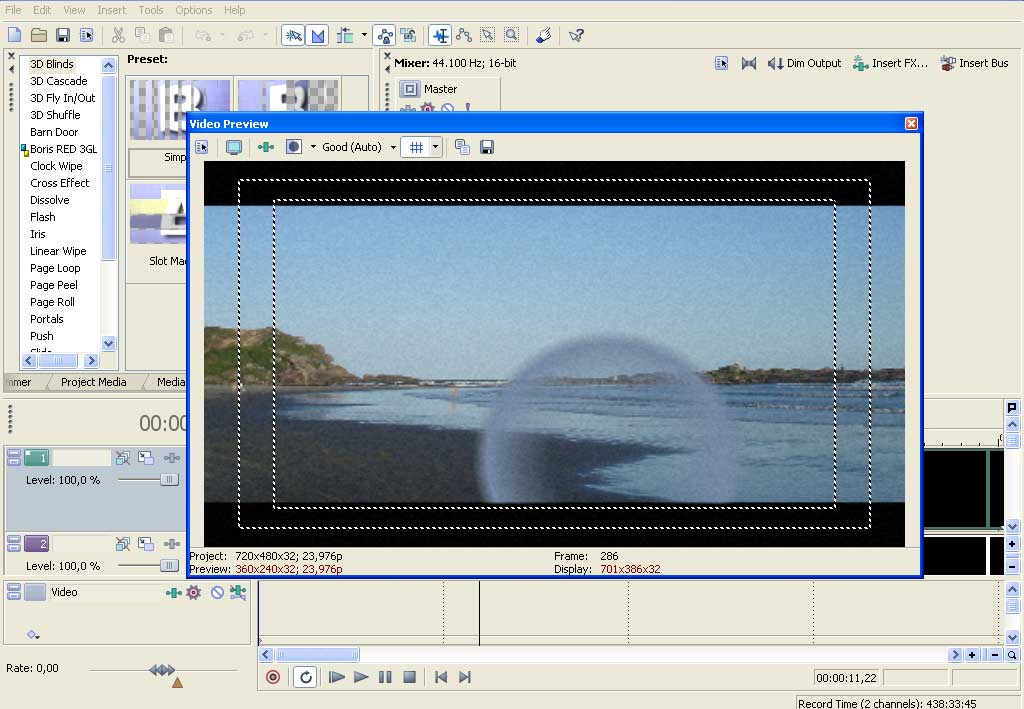
2)852x360
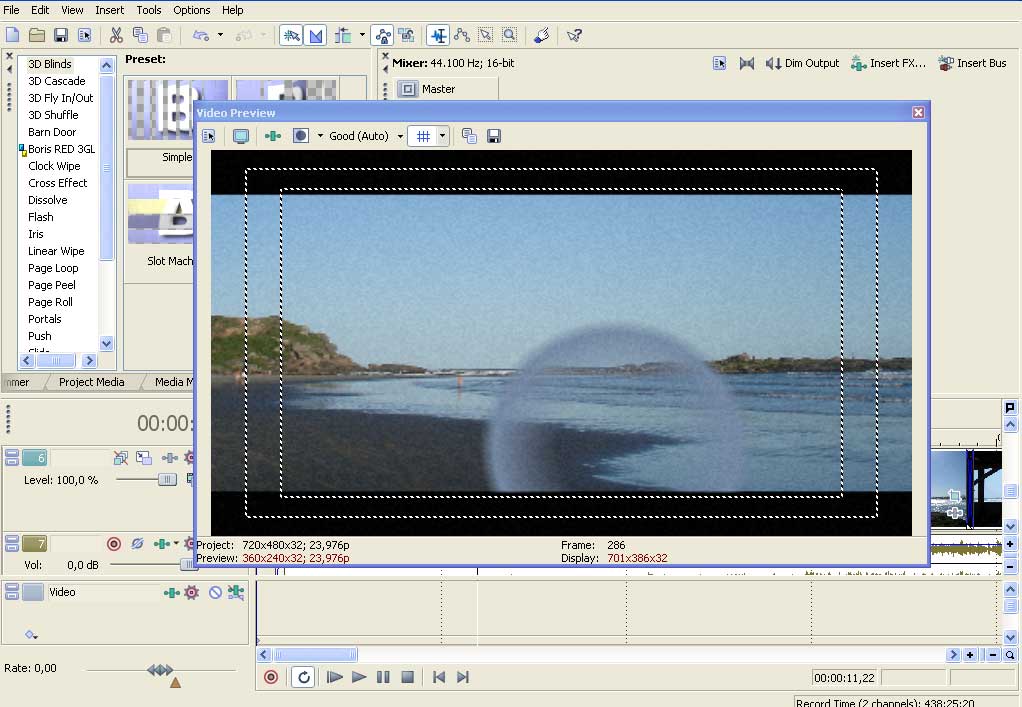
-
-I agree... The guy from Mexico is wrong.Such a bad idea.
-How about 852x360? I'm rendering as 16:9... remember? Look:720 x 368 + black bars to fill out the screen is correct for a 16:9 DVD
The video is MPEG, and if you've read the descriptions above, DVD MPEG typically uses just two DAR's for DVD video: 16:9 and 4:3. This isn't saying that you can't have 2.35, 2.20, or 1.85:1. It just says the Display Aspect Ratio property for the MPEG typically supports only those two Display Aspect's. It is independent of the Frame Size of the video. To make all of this work, they 'squeeze' the width -->[ ]<-- of any of the wider aspect ratios (1.85, 2.20, and 2.35), so it 'fits' into a 1.78 aspect ratio (This is called Anamorphic Widescreen. 16:9 video is just called Widescreen). To figure out a DVD's playback resolution, you do the same thing we did above for SVCD. You first find out it's TRUE DAR width, and then, from there, you can find out it's Pixel Aspect ratio.
For this example, lets assume a full D1 NTSC DVD, with a 2.35:1 Pixel Aspect Ratio. This is an anamorphic widescreen video, but the math is all still the same. Multiply the physical MPEG HEIGHT (480), by the mpeg's Display Aspect Ratio. Since this is a widescreen format, we'll use the 1.77 DAR (16:9), instead of 1.333:
480 * 1.77 = 852 (rounded to the nearest 4)
This is our videos true DAR WIDTH. We then divide this width by our PAR (Pixel Aspect Ratio) of 2.35:
852 / 2.35 = 360 (rounded to the nearest 4)
So this movies actual Video Image Area would be 852 x 360.
You would fill the remaining vertical area with letterboxing: 480 - 360 = 120 pixels of letterboxing
So now what? We have an 852x480 video (with letterboxing). That certainly won't fit within a DVD's specs of a 720 or 704 width? The answer is simple. Since the MPEG has an embedded DAR we simply resize our width to fit the standard we are encoding to (720 or 704 for DVD, 480 width for SVCD, 352 width for CVD, etc) - we do this in Vegas, configuring the project properties as DVD NTSC Widescreen 16:9 at 23,976 or 29,97.
-So I guess, the figures given (720x368) are not 100% correct. Please take a look at the picture and compare it with the previous ones, right above:
720x368
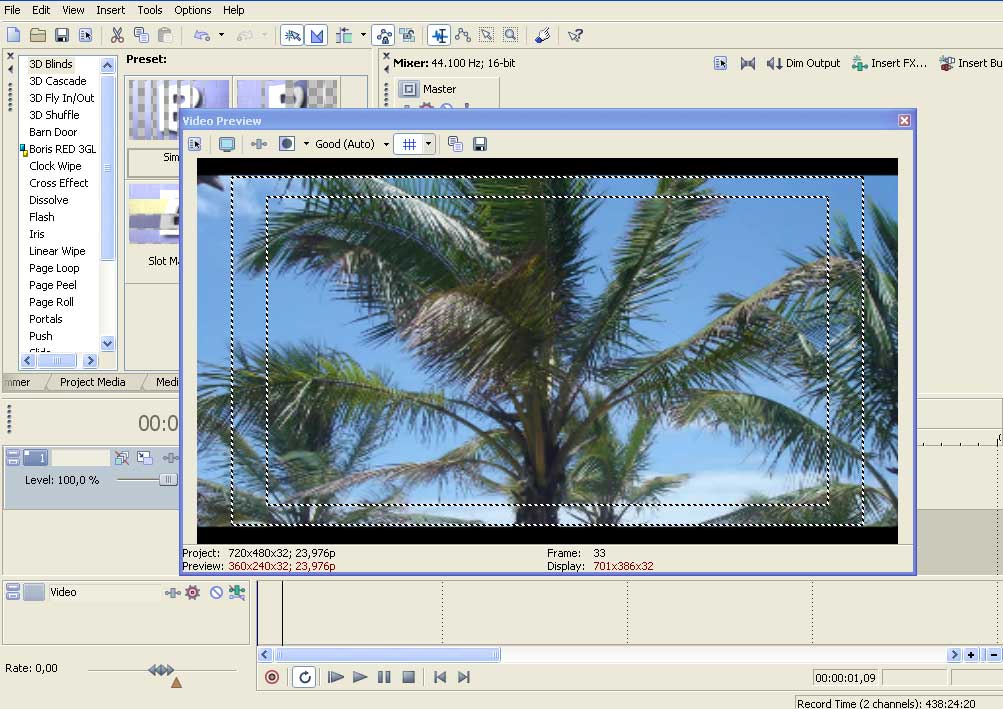
Anyone else, please? Thanks in advance
-
I'm surprised at you, Cunhambebe. I would have figured you'd have this down by now. Just use FitCD to get the script. And do the resize before adding in the letterboxing. For your 852x360 1:1 source, FitCD gives me:
LanczosResize(720,368,0,1,852,358)
AddBorders(0,56,0,56)
for 16:9 encoding. Personally, since so little is being cropped, I'd ignore that cropping and make it just:
LanczosResize(720,368)
AddBorders(0,56,0,56)
which is what disturbed1 said a long time ago.
It's closer to the mark than anything you've come up with since. It also depends on whether or not you use ITU resizing. I didn't in this case, but it ordinarily gives you more letterboxing and/or cropping.So I guess, the figures given (720x368) are not 100% correct -
Manono,
-Thank you very much for your excellent ideas, and thanks for FitCD. I'm sure it will help a lot with AviSynth. BTW, I'm very sorry if I didn't make myself clear. Maye it's my English, or I'm getting older and older :P lol What I'm trying to do here is something quite simple: rendering a file for DVD authoring (MPEG2) at 16:9 (NTSC Widescreen and letterbox), since any widescreen resolution is shown in the aspect ratio of 16:9 or even 4:3 (the only two ones shown by DVD players). The figures such as 852x360, for instance, are part of the excellent guide written by DJRumpy:I'm surprised at you, Cunhambebe. I would have figured you'd have this down by now.
https://forum.videohelp.com/topic174200.html
I think this guide is very good since it is very clear showing what happens to AVI containers and MPEG2 files and all the math involved when you try to find the aspect ratio. I still don't know what happend to me and my math, but I swear my mother did everything she could to help me find a solution for my math... So, it's as simple as that. There's nothing to do with MPEG4 part 2 (XviD) - in spite of the fact I'll convert the file later as XviD using AviSynth (720x304 - 720/2.35=306, 304 is a multiple of 16). I know AviSynth would help a lot and it is a good idea to write a script (as you have put it) and maybe even using HC encoder, but here I'm just using Sony Vegas. That'd be a good idea to render a video and then use the script for resizing and cropping, but there's no video here, just a bunch of pictures and Lightwave sequence files rendered at 16:9 [1,2121] as gunslinger have put it right above.
So what's the problem here? Well, as I watched the Bg Blue, a French movie that was encoded at 2.35:1, the display area is not as the same as the one suggested by disturbed1. The picture there is wider and the display 720x360 is shrunk as it can be seen on the pictures. Anyway, I'll try the script and check out the final result.
-Sorry my ignorance, but I still don't know what ITU resizing is :PIt also depends on whether or not you use ITU resizing.
gunslinger
-Thanks. As you can see manono, no one seems to agree around here. What's happening?FitCD is fine when you have existing 2.35 footage (example, an avi file) and want to create a DVD compliant mpeg encoding. However it is of little use when you are starting from scratch with photos and video of a different aspect ratio that needs cropping.
Let's wait for the next chapter of this novel
-
This is not at all nearly as difficult as you've made it.Originally Posted by Cunhambebe
I'll post the same correct answer I posted in the third post of this thread, and which has been echoed, also as being correct by other people.
720x368 + 56 + 56 encode as 16x9. It's as simple as that. Encode the footage as 16x9 and play it on a TV.Linux _is_ user-friendly. It is not ignorant-friendly and idiot-friendly. -
Cunhambebe-
I couldn't make any sense of that picture, so I ignored it. I don't use Vegas. However, most so-called 2.35:1 movies on DVD aren't really 2.35:1, but 2.39 or 2.40:1. Therefore, what is on a DVD doesn't really have much direct relation to you and the 1:1 852x360 AVI you created.
http://en.wikipedia.org/wiki/Aspect_ratio_(image)The most common aspect ratios used today in the presentation of films in movie theaters are 1.85:1 and 2.39:1...
.
.
2.39:1 35 mm anamorphic from 1970 onwards. Sometimes rounded up to 2.40:1. Often commercially branded as Panavision format or 'Scope.
So, maybe some widescreen movies you've looked at have more bars above and below than just the 56. I've seen quite a few on DVD that were up to about 2.45:1, perhaps due to cropping. And this isn't the true 2.55:1 and 2.76:1 movies on DVD which, of course, have an even greater amount of letterboxing. -
I've seen many 2.35:1 commercial DVDs encoded at 720x360 + 60 + 60. These may have included small black borders right and left too.
Note that 720x368 + 56 + 56 is good for MPEG efficiency because the borders of the image fall on 8 pixel boundaries. Motion vectors work on 8x8 blocks so you get the most efficient use of them. -
Hi there.
480 / 9 = 53.333...
53.333 * 16 = 853.333...
853.333 / 2.35 = 363.12056737588652482269503546099...
Now, the question is: What's up, Doc
 :P
:P
-
Manono: I understand what's going on when I resize to AVI's (XviD). The problem here was to find out the whole thing for MPEG2... Sorry.
Back to that guide:
https://forum.videohelp.com/topic174200.html
That's what I've found:
-Terrible, isn't it? lolol But that means a visual area of 720x360 + (PLUSSSSS) 120 (60+ 60 of letterboxing) - and yet, close to the figures 720x368 and 59 + 59 given by disturbed1.(...)The video is MPEG, and if you've read the descriptions above, DVD MPEG typically uses just two DAR's for DVD video: 16:9 and 4:3. This isn't saying that you can't have 2.35, 2.20, or 1.85:1. It just says the Display Aspect Ratio property for the MPEG typically supports only those two Display Aspect's. It is independent of the Frame Size of the video. To make all of this work, they 'squeeze' the width -->[ ]<-- of any of the wider aspect ratios (1.85, 2.20, and 2.35), so it 'fits' into a 1.78 aspect ratio (This is called Anamorphic Widescreen. 16:9 video is just called Widescreen).(...)
(...)480 * 1.77 = 852 (rounded to the nearest 4).This is our videos true DAR WIDTH. We then divide this width by our PAR (Pixel Aspect Ratio) of 2.35:
852 / 2.35 = 360 (rounded to the nearest 4)
So this movies actual Video Image Area would be 852 x 360.
You would fill the remaining vertical area with letterboxing: 480 - 360 = 120 pixels of letterboxing. So now what? We have an 852x480 video (with letterboxing). That certainly won't fit within a DVD's specs of a 720 or 704 width? The answer is simple. Since the MPEG has an embedded DAR we simply resize our width to fit the standard we are encoding to (720 or 704 for DVD, 480 width for SVCD, 352 width for CVD, etc).(...)
(...)If I was encoding the same 2.35 aspect AVI to a 16:9 NTSC DVD, then I would use ""Table 2"" (for 16:9 video) and resize my AVI to 720x360 and fill in the remaining 360-480 vertical with letterboxing.
TABLE 2
When encoding to a 16:9 Aspect MPEG (*see note below*)
NTSC DVD 16:9
704x360
704x432
720x360 -> close to 720x368, filling the remaining area with letterboxing
720x432
About the excellent application, the tiny little FitCD:
1) Brazil is not PAL, but PAL-M (M comes from the NTSC) that has the same resolutin of NTSC, but using PAL color palette, running at 29,97;
2) Brazil uses NTSC for DVD, exactly like USA - all TV sets are made with the 2 systems nowadays: PAL-M for Public Broadcasting and NTSC for DVD. The only one thing that differs is the region (here is 4 - Australia and South America - but this is for commercial DVDs);
3) The figures you've found with FitCD seems related to PAL, not NTSC.
4) Here are the figures I've found for 852x360:
LanczosResize(720,304,0,0,852,360)
AddBorders(0,88,0,88)
BTW, 720x304 is the same thing I was making in Vegas: open Pan/Crop, unlock the Pan/Crop button and configure the following values for width and height: 720x304. On the other hand, FitCD shows a real aspect of 2,8766.
Now, using the figures given by disturbed one, 720x368, makes FitCD show me the following results (anamorphic box is checked):
AddBorders(0,56,0,56) - plus a real aspect of 2,378, which is closer and more correct according TO THE APPLICATION than the values given by the chart above and the guide (includding its math). So, where should I go? (please, there may be chidren around here) :P
So, I guess, the guide says 852x360 and then tells to resize it to 720x360 (368 would work too since 852 / 2.35 = 362,553191). That makes me thank disturbed1 and also the one who wrote the guide
Thanks to my friend, manono:
-the picture is showing an anamorphic video at 720x360 also 368 as distubed1 one has told me to do so.I couldn't make any sense of that picture, so I ignored it.
-There's no AVI overthere (not even an uncompressed one). There's only a virtual project let's say, that will be rendered as MPEG2 on the fly...I don't use Vegas. However, most so-called 2.35:1 movies on DVD aren't really 2.35:1, but 2.39 or 2.40:1. Therefore, what is on a DVD doesn't really have much direct relation to you and the 1:1 852x360 AVI you created.
Thanks to jagabo as always:
MidzukiNote that 720x368 + 56 + 56 is good for MPEG efficiency because the borders of the image fall on 8 pixel boundaries. Motion vectors work on 8x8 blocks so you get the most efficient use of them.
-480 times 1,77 = 849,6 (multiple of 4 is 852)853.333 / 2.35 = 363.12056737588652482269503546099...
Now, the question is: What's up, Doc
852 / 2.35 = 862,5 (that makes 360 or 368)
852 can be resized to fit the width to 720, therefore 852x360/368 = a visual area of 720x360/368.
Hope this time everything is allllll right.
Cheers,
Mark -
That would make
480 times 1,7777777 = 853,3333333296/2.35 = 363,1205 (closer to 360 than 368) -
You guys are quibbling over a ~1 percent difference in AR. Who cares. You won't be able to tell the difference without a tape measure. If you're watching on a CRT the TV's AR is probably off by more than that anyway. And if the source is some AVI file you've downloaded off the internet who knows what the ripper did with the AR.
-
I guess you've never used fitCD before:Originally Posted by Cunhambebe
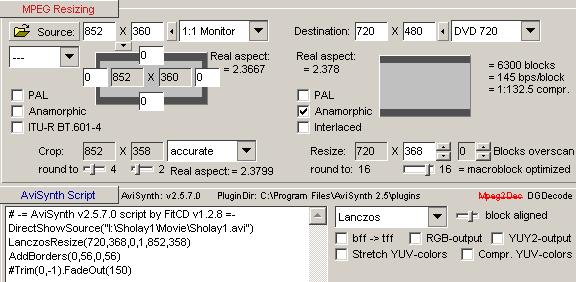
Originally Posted by Cunhambebe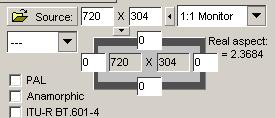
-
 Linux _is_ user-friendly. It is not ignorant-friendly and idiot-friendly.
Linux _is_ user-friendly. It is not ignorant-friendly and idiot-friendly. -
LOLOLOLOL
But manono, the source I guess is 720 DVD and not 1:1... I don't know. Besides, you're right I've never used this application before. Anyway, you're right. So why the final result at 720x368 doesn't show the same area when I play, for instance a 2.35:1 anamorphic DVD movie such as The Big Blue (using PowerDVD)? I mean, the movie seems not to have black bars (letterboxing). Maybe I'm asking a wrong question. Let's see this one: How can I render anamorphic 2.235:1 in an aspect of 16:9? Thanks in advance, thanks also to disturbed1 for so many laughs here.
Edit: jagabo wrote
-Is that what I'm looking for?In TMPGEnc set the Source Asepct Ratio to 1:1 VGA, set Video Arrange Method to Full Screen (Keep Aspect Ratio). The output frame size should be 720x480, and the Aspect Ratio 16:9. That will create a 16:9 anamorphic MPEG2 file. If you prefer a letterboxed 4:3 file set The Aspect Ratio to 4:3. -
That old quote was for a square pixel AVI file being converted to anamorphic wide screen DVD. It tells TMPGEnc that your source is square pixel and it should do whatever is necessary to encode it as an anamorphic widescreen DVD while filling as much of the screen as possible. If you start with a 640x272 (~2.35:1) square pixel AVI file it will do what has been discussed -- stretch the frame to 720x36x and add borders to fill out the 720x480 frame.
I don't know what you mean. Are you saying you want your 2.35 AR movie to completely fill a 16:9 TV screen?Originally Posted by Cunhambebe
This Big Blue?Originally Posted by Cunhambebe
http://www.imdb.com/title/tt0094738/
It's 1.66:1. It probably has small pillarbox bars on DVD.
Similar Threads
-
Skippy/Jumpy Render output Issue Premiere CS5 to MPEG2
By dragan1975 in forum Video ConversionReplies: 8Last Post: 24th Dec 2011, 19:39 -
What is better to render with?
By ingeborgdot in forum EditingReplies: 8Last Post: 11th Sep 2011, 13:10 -
sync without render?
By mrjoetoff in forum Newbie / General discussionsReplies: 0Last Post: 23rd Aug 2009, 11:04 -
What quality do I render to?
By seven1970 in forum Newbie / General discussionsReplies: 6Last Post: 22nd Feb 2009, 16:59 -
Vegas smart render using mpeg2 ac3 files
By Ferdinand in forum EditingReplies: 6Last Post: 9th Nov 2008, 11:00




 Quote
Quote